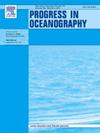Variability of the transition zone chlorophyll front and its relationship to large-scale climate phenomena
IF 3.6
3区 地球科学
Q1 OCEANOGRAPHY
引用次数: 0
Abstract
The Transition Zone Chlorophyll Front (TZCF) is considered a foraging corridor for many commercially important predator species in the North Pacific, including tunas and swordfish, as well as for protected turtles. Here we use nearly three decades of satellite remotely sensed ocean color data to characterize the trends and variability of the TZCF properties, including its location, west/east slope, and the degree of its meandering, and investigate the relationships of these properties with large-scale climate phenomena in the tropics and in the North Pacific. We found that the interannual variability of TZCF properties is associated with the El Niño-Southern Oscillation (ENSO), the Pacific Decadal Oscillation (PDO), and the North Pacific Gyre Oscillation (NPGO) to various degrees. Variability in the latitude of the front during winter is associated with the PDO and ENSO and is related to anomalies in zonal wind strength that are typical of these climate patterns. Consistent relationships are also found between the climate modes and TZCF slope, and the degree of meandering is best correlated to the NPGO. There has been a significant northward movement of 8.25 km/year of the TZCF, as defined by the 0.2 mg/m3 chlorophyll contour, over the past 26 years. The long-term trend in TZCF location corresponds to a weakening in westerly winds near the front and weakened gyre circulation as manifested by more frequent negative NPGO since 2011. The study extends our previous understanding of the TZCF variability and its linkage to the large-scale climate modes, providing a more robust basis to explore climate impacts on the fisheries linked to TZCF variability in the Northeast Pacific.
过渡带叶绿素锋的变率及其与大尺度气候现象的关系
过渡区叶绿素锋(TZCF)被认为是北太平洋许多重要商业捕食物种的觅食走廊,包括金枪鱼和旗鱼,以及受保护的海龟。本文利用近30年的卫星遥感海洋颜色数据,分析了其位置、西/东斜度和蜿蜒程度等TZCF特征的变化趋势和变异性,并探讨了这些特征与热带和北太平洋大尺度气候现象的关系。研究发现,TZCF特性的年际变化与El Niño-Southern涛动(ENSO)、太平洋年代际涛动(PDO)和北太平洋环流涛动(NPGO)有不同程度的关联。冬季锋面纬度的变化与PDO和ENSO有关,并与纬向风强度的异常有关,这是这些气候模式的典型特征。气候模式与TZCF坡度之间也存在一致的关系,其中蜿蜒程度与NPGO的相关性最好。根据0.2 mg/m3叶绿素等高线的定义,在过去26 年中,TZCF有8.25 km/年的显著北移。TZCF位置的长期趋势对应于锋面附近西风减弱和环流减弱,表现为2011年以来NPGO负环流更加频繁。该研究扩展了前人对TZCF变率及其与大尺度气候模式联系的认识,为探索气候对东北太平洋TZCF变率相关渔业的影响提供了更有力的基础。
本文章由计算机程序翻译,如有差异,请以英文原文为准。
求助全文
约1分钟内获得全文
求助全文
来源期刊

Progress in Oceanography
地学-海洋学
CiteScore
7.20
自引率
4.90%
发文量
138
审稿时长
3 months
期刊介绍:
Progress in Oceanography publishes the longer, more comprehensive papers that most oceanographers feel are necessary, on occasion, to do justice to their work. Contributions are generally either a review of an aspect of oceanography or a treatise on an expanding oceanographic subject. The articles cover the entire spectrum of disciplines within the science of oceanography. Occasionally volumes are devoted to collections of papers and conference proceedings of exceptional interest. Essential reading for all oceanographers.
 求助内容:
求助内容: 应助结果提醒方式:
应助结果提醒方式:


